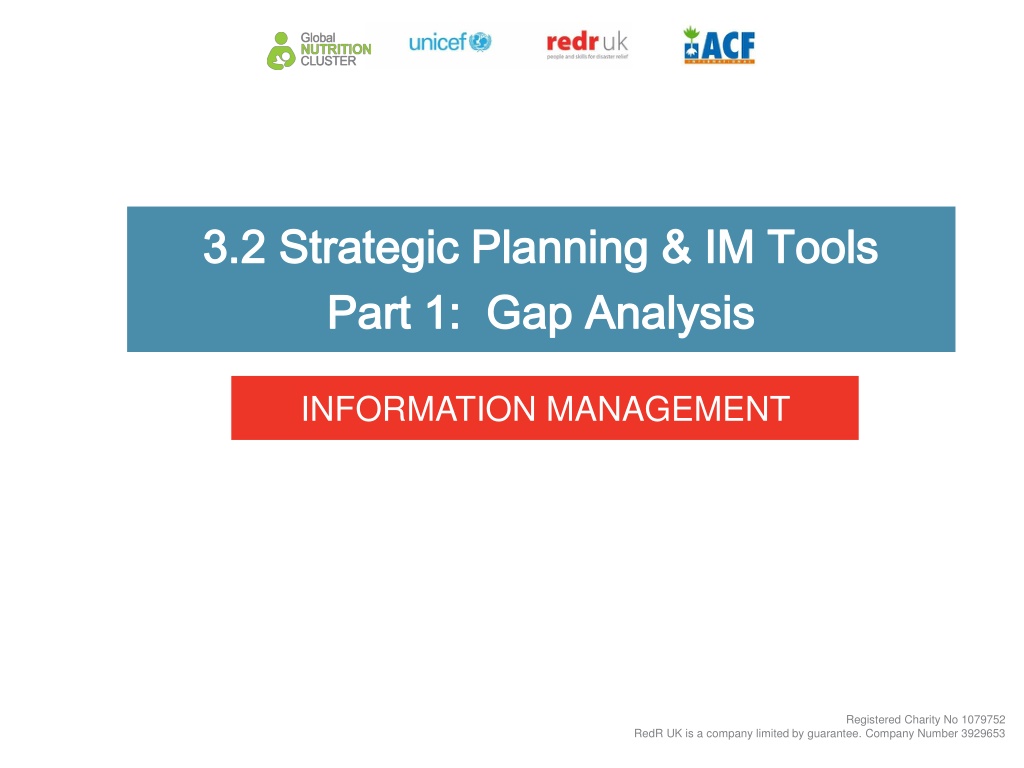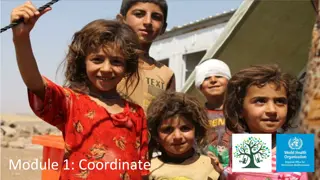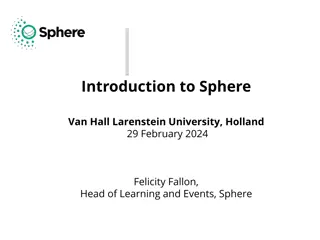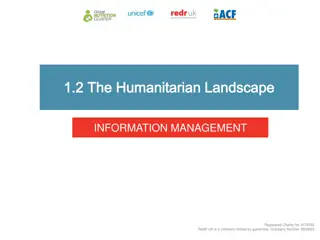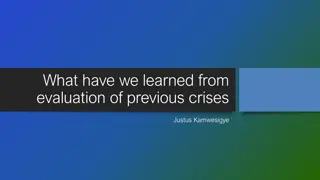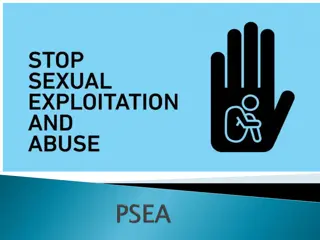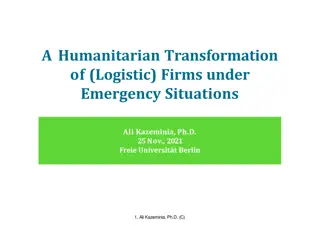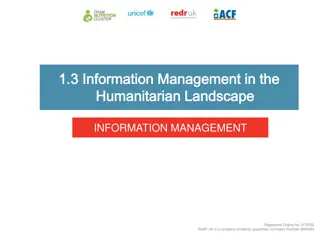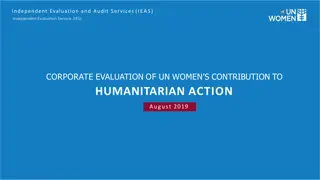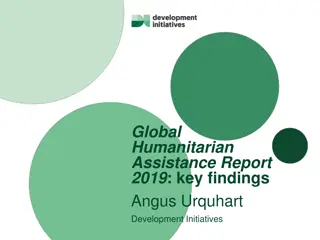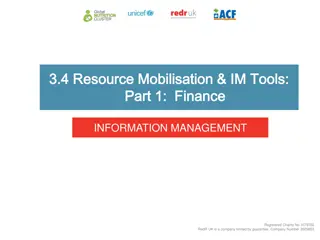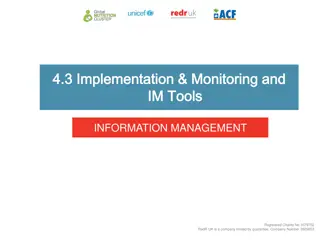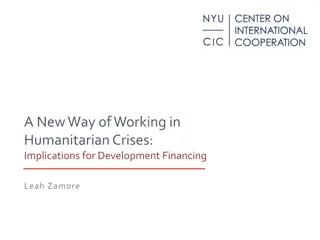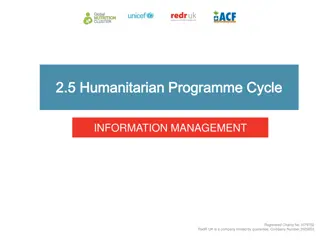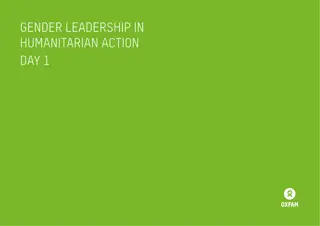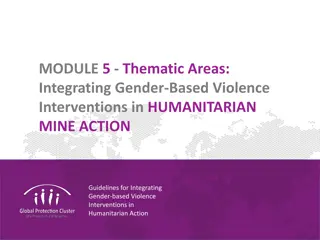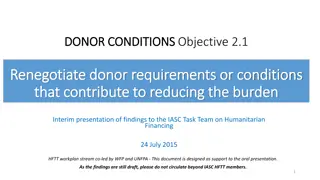Humanitarian Response Planning and Implementation Tools
This content discusses various tools and guidelines used in the strategic planning and implementation stages of humanitarian response operations. It covers gap analysis, flash appeals, gender considerations, humanitarian response plans, secondary data analysis, and GNC IM tools for informing strategic planning. These tools help organizations in assessing needs, setting priorities, mobilizing resources, and monitoring activities to effectively respond to emergencies.
Download Presentation

Please find below an Image/Link to download the presentation.
The content on the website is provided AS IS for your information and personal use only. It may not be sold, licensed, or shared on other websites without obtaining consent from the author. Download presentation by click this link. If you encounter any issues during the download, it is possible that the publisher has removed the file from their server.
E N D
Presentation Transcript
3.2 Strategic Planning & IM Tools 3.2 Strategic Planning & IM Tools Part 1: Gap Analysis Part 1: Gap Analysis INFORMATION MANAGEMENT Registered Charity No 1079752 RedR UK is a company limited by guarantee. Company Number 3929653
Flash Appeal Concise, top-line analysis directly related to rapid needs assessment Sudden onset: issued three to five days Protracted or slow onset: when there is an unforeseen spike in needs or a change in the context Sets out priority actions and preliminary requirements Used to allocate funds for a 3-6 month duration Project-based with financial requirements A Flash Appeal may sit separately to an existing country HRP.
Gender considerations for planning any project The IASC Gender with Age Marker codes projects proposals for gender equality programming. The IASC Gender and GBV Guidelines for protection and prevention. Because the Flash Appeal is project-based, projects must be assessed using this tool.
Humanitarian Response Plan Directly related to needs assessment (HNO or occasionally a MIRA) Sudden onset emergencies: Revised/developed within 30 days. Protracted emergencies: a yearly or multi-year plan. Sets overall direction and strategic objectives of response 2 Parts: 1) a country strategy and 2) cluster/sector response plans. Roles & Responsibilities HC/HCT define overall strategic objectives and sets priorities OCHA supports the planning process by consolidating data, agreeing planning figures, drafting and finalising the plan. The inter-cluster coordination group supports these efforts Clusters and cluster partners contribute to development of the plan And IMOs???
Secondary data Needs analysis Capacity mapping 1. Identify gaps including gender and GBV 2. Review the priority needs considering women and most marginalized 3. Establish the scope or boundaries 4. Take into account those needs being addressed by others. 5. Determine the target caseload 6. Describe the response priorities Resource mobilisation Implement plan Advocacy and communication Monitor and review
What GNC IM Tools inform the Strategic Planning stage? Surveys database Key datasets HRP tips 4 W HIR Gap analysis tool M&E Framework Caseload targets & supplies IM Checklist
What GNC IM Tools inform the Strategic Planning stage? Surveys database Key datasets HRP tips 4 W HIR Gap analysis tool M&E Framework Caseload targets & supplies IM Checklist
HRP Tips Assists NCC and partners in strategic and project planning For IMOs: Information to support caseload calculation, indicators for interventions All chapters organised in similar way with guidance on Objectives and Specific Objectives, target groups, calculating expected caseload, sample activities and tips and suggested indicators. Also provides guidance for monitoring CC and AAP Guidance tool maintained by the GNC
Humanitarian Indicators Registry Menu of indicators for countries to select relevant standard indicators. These indicators can also be adapted when needed Contains needs assessment and performance monitoring indicators for all clusters Contains over 100 indicators for nutrition-specific indicators and also other sector indicators that can be relevant for the nutrition cluster Maintained and managed at global level for the use at country level
https://www.humanitarianresponse.info/applications/ir/indicatorshttps://www.humanitarianresponse.info/applications/ir/indicators
Nutrition-related indicators available as Excel file in IM Toolkit
3W/4W-Whos doing what, where and when Shows operational presence of NC partners and locations within an emergency. It is a tool that is used to avoid duplications and to identify gaps. Adaptable to the context Can be used in other forms, such as web-based platform Cluster partners submit 4W data to be analysed by the IMO IMO compiles, analyses and validates the information and produces information products on the basis of it Submitted to OCHA to produce inter-cluster reports
4W Information Organisation details Organisations by county Nutrition organisations per programme Agencies per county per programme Ongoing programmes
Gap Analysis Computer Lab Gap Analysis Computer Lab INFORMATION MANAGEMENT Registered Charity No 1079752 RedR UK is a company limited by guarantee. Company Number 3929653
Gap analysis tool The Gap analysis tool is an adaptable Excel database tool It was created to easily identify gaps to in resources, geographical coverage, guidelines, funding, assessments, progress towards targets. Contains spreadsheets with information about geographical coverage, guidelines, funding, assessments, progress towards targets. The GNC is currently developing a word template for consolidated gap analysis report, that is based on the use of current tool The Gap analysis tool would likely be maintained by IMO
Exercise: Gap analysis tool Using the 3W, complete what you can in the Geographic Coverage spreadsheet in the Gap analysis tool (15 minutes) Debrief questions What information is missing to be able to fully complete the Geographic Coverage? What would be possible sources of information to complete the spreadsheet? What strategies could be used for gathering the missing data?
